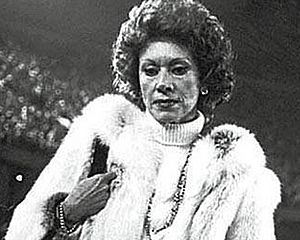Ernestina Herrera de Noble facts for kids
Quick facts for kids
Ernestina Herrera de Noble
|
|
|---|---|

Herrera de Noble at the 1978 World Cup final
|
|
| Born |
Ernestina Laura Herrera
7 June 1925 Buenos Aires, Argentina
|
| Died | 14 June 2017 (aged 92) Buenos Aires, Argentina
|
| Resting place | La Recoleta Cemetery |
| Occupation | Grupo Clarín (Chairperson) |
| Spouse(s) |
Roberto Noble
(m. 1967; died 1969) |
| Children | 2 |
Ernestina Laura Herrera de Noble (born June 7, 1925 – died June 14, 2017) was an important Argentine publisher and business leader. She owned the largest share of the Grupo Clarín media company. She also directed the main newspaper, Clarín. She was the first woman to lead a major newspaper in South America.
Contents
Her Early Life and Career
Ernestina Laura Herrera was born in Buenos Aires, Argentina, in 1925. When she was younger, she was a Flamenco dancer. Around 1950, she met Roberto Noble, who had started the Clarín newspaper.
They got married in 1967. Sadly, Roberto Noble passed away from cancer on January 12, 1969.
Leading the Clarín Newspaper
After her husband's death, Ernestina inherited a big part of Clarín. Since 1965, Clarín had been Argentina's most popular newspaper. But even with many readers, the newspaper was having money problems when Mrs. Noble took over.
She asked for help from Rogelio Julio Frigerio, an economist who was a friend of her late husband. In 1971, he lent Clarín US$10 million. The newspaper continued to support Frigerio's ideas, which focused on the government helping with big projects and making goods inside the country instead of buying them from elsewhere.
Following Frigerio's advice, Mrs. Noble brought in Héctor Magnetto. He became responsible for the newspaper's money matters.
Growing the Media Company
In 1977, Clarín joined with its main competitors, La Nación and La Razón, and the Argentine government. They partnered in Papel Prensa, which was the biggest company in Argentina that made newsprint (the paper used for newspapers). This helped Clarín's finances even more.
Under Mrs. Noble's leadership, Clarín grew a lot in the Argentine media world.
- In 1990, they bought two other popular media outlets: Radio Mitre and Channel 13.
- In 1992, they bought Multicanal Cable TV.
- They also bought other radio stations and magazines.
She also worked with La Nación again. In 1982, Clarín joined them to create a news service called Diarios y Noticias (DyN). In 1997, they formed a holding company called Cimeco S.A. This company bought large shares in many local newspapers, like Los Andes in Mendoza and La Voz del Interior in Córdoba.
By 1999, all these businesses were combined to form Grupo Clarín. This group became the most important media company in Argentina. Mrs. Noble, along with longtime directors Héctor Magnetto, José Antonio Aranda, and Lucio Rafael Pagliaro, controlled it.
Personal Challenges
Ernestina Herrera de Noble faced some personal challenges and legal cases.
- She had a long-standing disagreement with Roberto Noble's only daughter, Guadalupe Noble, about who should control parts of the company. They reached a partial agreement, but some parts of the dispute about Grupo Clarín remained.
- In 2002, a judge ordered her to give DNA samples for her two adopted children, Marcela and Felipe. This was part of a legal case about their identity. She was allowed to refuse the samples in 2008, but the case continued. In 2016, she was found innocent in a case about the 1977 purchase of Papel Prensa.
Ernestina Herrera de Noble passed away on June 14, 2017, at the age of 92.
See also
 In Spanish: Ernestina Herrera de Noble para niños
In Spanish: Ernestina Herrera de Noble para niños

